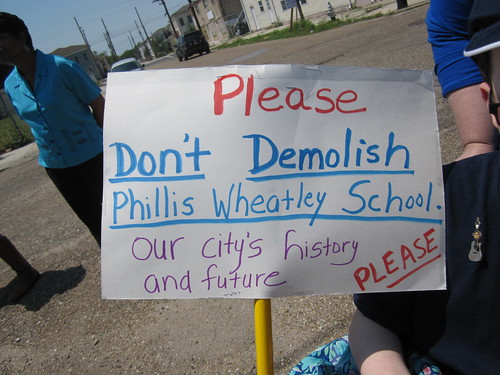
I started Regional Modernism: the New Orleans Archives 3 years ago to document the process of documenting modernism in New Orleans. I had just lost my 1st building, a moderne structure on Canal and Treme. I'd only photographed it weeks before and was shocked to see it reduced to rubble before I had a chance to get to know it. A mission made in a moment.
The Regional Modernism course at Tulane School of Architecture in the spring of 2008 was less about teaching and more about discovering and documenting. The students and I started by merging data from the Southeastern Architectural Archives, the New Orleans Public Library's City Archives and Samuel Wilson's Guide to New Orleans Architecture into a map of nearly 850 modern buildings in New Orleans, of which 250 are chronicled in the Regional Modernism flickr account. Soon (very soon) the Regional Modernism iphone app will be released. It includes nearly 150 modern buildings, lost, extant and threatened.
Through this process, I've learned not just about identifying modernism in our midst, but also about its significance and relationship to the history of our built environment. In 1955 Progressive Architecture's 2nd Annual Design Awards recognized more buildings by architects from New Orleans and Louisiana than any other city or state in the nation. That's right. Before New Orleans was the city that care forgot, it was one of the most architecturally progressive cities in the nation.
Yet we are losing significant modern architecture at a truly alarming rate. In the mid 20th century 6 New Orleans buildings received national AIA Awards. Soon two thirds of these will be gone.
Yet we are losing significant modern architecture at a truly alarming rate. In the mid 20th century 6 New Orleans buildings received national AIA Awards. Soon two thirds of these will be gone.
Since 2008 the mid 20th century modern public school has become an endangered species in New Orleans. Of the city's 30 public schools designed and built in the 1950s, today only 3 are left standing. Soon only 1 may remain. At the Hands Around Wheatley gathering in April, John Stubbs offered this sobering statistic:
Since the World Monuments Watch List program was established in 1995, we’ve listed nearly 600 sites in ninety-one countries. In Moscow, Tel Aviv, Los Angeles and Havana others have found ways to preserve threatened modern buildings, surely we can do the same with Wheatley School. If the Wheatley school is lost through demolition, it will be the 1st site on our World Monuments Watch List that died in our hands.
This week the Louisiana Landmarks Society announced its New Orleans 9 Most Endangered List for 2011. The current list recognizes Abandoned and Neglected Public School Buildings City-Wide including the "Phillis Wheatley School in Treme, once internationally known for its cutting-edge mid-20th century design." The 2008 list included Mid-century Modern Public Schools. Of the 4 schools cited in 2008, McDonogh 39 and Carver have been razed and demolitions are pending for Wheatley and Lafon.
Next week we welcome the 2011 American Institute of Architects annual meeting to New Orleans. DOCOMOMO Louisiana will present an exhibit on mid-century modern schools at the Preservation Resource Center. On view will be reproductions of architect Charles Colbert's 9 presentation boards of drawings of the Phillis Wheatley Elementary School. The exhibit will also feature contemporary photography of the Phillis Wheatley, Thomy Lafon and George Washington Carver Schools by Emily Ardoin, John Klingman, Anthony DelRosario and Francine Stock. Phyllis Montana-Leblanc's petition to SAVE PHILLIS WHEATLEY ELEMENTARY SCHOOL IN NEW ORLEANS! SAY "NO!" TO DEMOLITION now has 1555 signatures. Add yours today.
You can also email your comments directly to to Mayor Mitchell J. Landrieu: mayor@nola.gov
It's not too late to raise your voice in support for the preservation of this significant and truly unique school building.
Francine Stock
[photo: John Stubbs, World Monuments Fund]
No comments:
Post a Comment